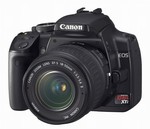Canon Rebel XTi / 400D Digital Camera
![]()
![]()
![]()
![]()
![]()
![]()
![]()
![]()

We have a fair number of digital cameras in house – you’d probably expect that. None the less, the Rebel XTi remains a house favorite. Cool, flexible and capable of using our disturbingly large collection of Canon EF lenses – some of which date back twenty years or more – this is a camera to engender considerable squabbling over.
The Rebel XTi has a lot in common with Canon’s EOS 35-millimeter film cameras from back in the twentieth century. It’s a true single-lens reflex camera, allowing its users to see through the same lens as it uses to take pictures. Its interchangeable lenses can permit its view to be anything from a wide-angle fisheye to a telephoto lens capable of making paparazzi blush. We even tried it with a Meade astronomical telescope, a toy we use as the long lens of the gods.
Behaving like a traditional high-end film camera, the Rebel XTi had a learning curve of less than a minute. Its controls are intuitive, and everything behaved exactly as you’d expect. Having had the foresight to charge its battery prior to the formal unboxing, it was snapping away immediately.
The Rebel XTi is extremely small and light compared to its 35-millimeter ancestors, and even compared to earlier Canon digital SLR cameras. It has a generous preview screen across its back, and a bright, well-laid out viewfinder. It offers multiple focus zones, and a truly demonic focusing system that just can’t be fooled by anything.
This includes Morgan the newf. Morgan – a black dog who likes to sleep on a black carpet – has successfully foxed the automatic focusing systems of every digital camera pointed at him. The Rebel XTi was the first to defeat Morgan, an impressive accomplishment.
The Rebel XTi is built around a ten-megapixel image sensor. At this resolution, skin tones appear a lot more lifelike, losing entirely the tendency to make human subjects look like they’ve spent the afternoon on deck without any sunblock. One catch to sensors of this size, however, is that a grain of dust is typically larger than one of the sensor’s pixels – dust on your image sensor will leave visible defects in your photographs. This issue is exacerbated in a single-lens reflex camera, in that the sensor is exposed to air when you change its lens. The Rebel XTi includes an automatic cleaning mode that vibrates the sensor every time the camera is switched off, dislodging any dust that’s settled on it.
The Rebel XTi offers a selection of general and specific shooting modes. Select the green rectangle fully-automatic mode and the camera takes its best guess at selecting appropriate shutter speed and aperture settings based in what it sees through its lens. It guesses well surprisingly often, and this option is all you’ll ever need for taking pictures at family gatherings, snapping pictures of your unwanted junk for e-Bay or amateur camera-safaris into the wilds of cottage country.
Several fully automatic specialized modes are also available – the Rebel XTi can be configured to shoot portraits, landscapes, sporting events, night scenes and so on.
Finally, it offers more traditional options for aperture and shutter speed preference, and for fully manual settings if you really know what you’re doing.
Users with highly specific requirements – or an inability to refrain from playing with menus – can configure the Rebel XTi to behave as if it were a film camera using specific types of film, too. I’m guessing that only photographers with f-stop charts tattooed on their inner eyelids will actually want to do this.
The Rebel XTi includes a printer interface, allowing it to send its pictures to a suitable PictBridge printer without the requirement of a computer in the middle. We tried it with a Canon Selphy dye-sublimation printer – the results were breathtaking.
The Rebel XTi stores its pictures on Compact Flash memory cards. You can download pictures to a PC through its USB interface, but for a few dollars more, you can get a memory card reader for your computer and just copy files from its card to your hard drive.
The top of the Rebel XTi’s viewfinder housing hides a flash that will pop up automatically when its required. It also supports a hot shoe for a more sophisticated flash – while this looks like a traditional flash shoe, it has a decided preference for Canon’s newer Speedlite flashes. The Rebel XTi does excellent work with a Speedlite attached – we were never able to get it to take proper flash pictures with a non-Canon flash.
It would be hard to find anything resembling a shortcoming in the Rebel XTi – it clearly reflects a long line of ancestors, and a great deal of innovation. Its access to hundreds of Canon and aftermarket autofocus lenses is a worthwhile feature. This includes Canon’s latest generation of image-stabilized lenses, which use internal gyroscopic stabilization to fiddle the lens elements and compensate for camera shake. The lens included with the Rebel XTi doesn’t include this feature, but Canon’s image stabilized lenses are not unreasonably priced.
As serious digital photography goes, the Rebel XTi would be hard to compete with. Considering its price – well under a thousand dollars – it’s as close to perfect as anything with batteries could hope to be.